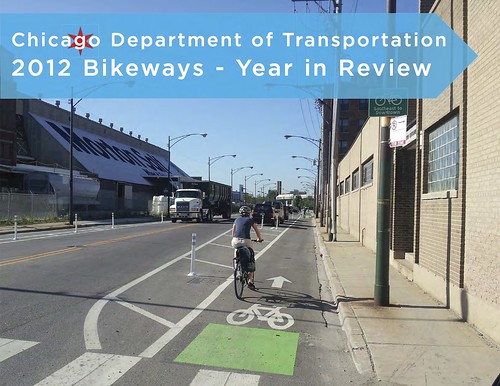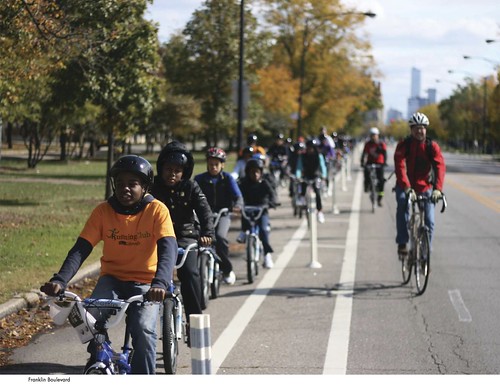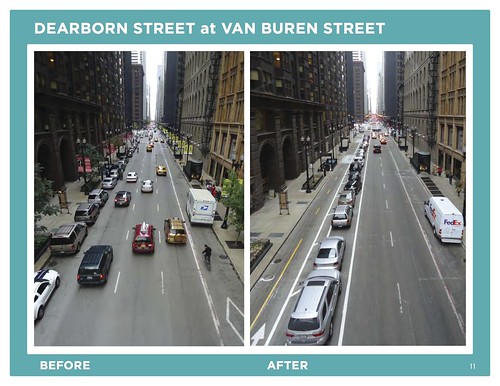The Chicago Department of Transportation recently gave itself a well-deserved pat on the back with the release of the 2012 Bikeways – Year in Review report. The new document does a great job of getting the message across about just how much the city accomplished last year in building new bikeways and how these improvements will benefit all Chicagoans.
The numbers in the report show that CDOT got an extraordinary amount of work done in 2012. The agency installed or restriped 39 miles of bikeways last year, including 9.4 miles of protected bike lanes and 17.65 miles of buffered lanes. Along with the two miles of protected lanes and one mile of buffered lanes added in 2011, the year Mayor Rahm Emanuel took office, this brings Chicago up to 30 miles of bikeways that provide more separation from cars than a typical painted bike lane. This puts the city well on the way toward achieving the mayor’s (somewhat revised) goal of installing 100 miles of protected and/or buffered lanes by 2015. According to CDOT the city now has more than 204 miles of bikeways altogether.
Along with the sheer mileage, the city accomplished a list of other achievements last year that kept CDOT’s small bike program staff often working far more than 40-hour weeks. It experimented with new treatments, like the “bicycle priority lane” markings on Wells Street between Wacker Drive and Madison Street which, along with signage, makes it clear to drivers that bicyclists have the right to ride in the middle of the lane. A snippet of contra-flow bike lane on Albion Street in Rogers Park now allows cyclists to safely detour around the Sheridan Road speedway. And the city helped install three on-street bike corrals in Andersonville and Pilsen, showing that curbside asphalt can be put to more efficient and creative uses than just warehousing motor vehicles.
Eight of Chicago’s treacherous metal-grate bridge decks were made safer with the addition of concrete infill or “Kathy Plates” -- fiberglass decking named for Kathy Schubert, who several years ago started a letter writing campaign to fix the bridges after she split her knee open on LaSalle Street. Most importantly, CDOT released the Streets for Cycling 2020 Plan, a blueprint for creating a 645-mile network of bikeways by the end of the decade, with the goal of ensuring every resident lives within a half mile of a lane, path, or other bike route.
But the most memorable 2012 achievement was the “game-changing” installation of the Dearborn Street two-way protected bike lane. By removing a car lane on a roadway that runs through the heart of the Loop to make room for this innovative bikeway, which includes Chicago’s first dedicated bike traffic signals, the city proved that its support for sustainable transportation is more than just lip service. Other towns took note, and there were envious posts on bike blogs from New York to Seattle.
Full of photographs, including several before-and-after shots, the report illustrates how protected bike lanes make the streets safer for everyone by shielding cyclists, shortening crossing distances for people on foot and discouraging speeding, As stated in CDOT’s press release for the report, “A driving principle of the [2020 Plan] is the concept of balancing roadway space to ensure that all users – pedestrians, transit users, bicyclists and motorists – can travel along and across the street safely.” With this document, CDOT makes a compelling argument for that strategy.








